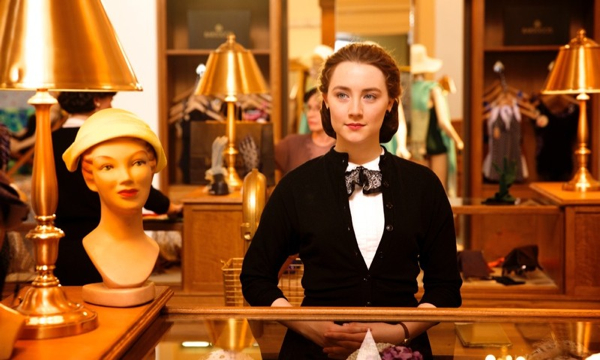Movie review by Greg Carlson
John Crowley’s film of Colm Toibin’s popular novel “Brooklyn” features a tremendous Saoirse Ronan – whose thoughtful and inviting presence is more than enough to recommend the movie, despite some of its easy calculations. As Eilis Lacey, a young woman who leaves her home and family in Enniscorthy, Ireland for the promise of a bigger life in America, Ronan adds another noteworthy performance to her already impressive filmography. Set in the early 1950s, “Brooklyn” trades to a significant degree on a kind of highly filtered, golden nostalgia, and opinions are divided on the success of this tactic.
Nick Hornby’s screenplay retains the soul of Toibin’s book: Eilis’ painful homesickness and heartsickness, the old-fashioned benevolence of the Catholic Church, and Eilis’ disequilibrium over her national identity – especially when she returns to the country of her birth. The movie does, however, differ from the novel in several notable aspects. The opening is more streamlined, the strange scene between Eilis and Miss Fortini in the dressing room is altered, and the film makes only the tiniest nod to the African American customers of Bartocci’s department store.
The biggest change, however, is Crowley’s decision to conclude with a definitive resolution concerning the state of Eilis’ relationship with first love Tony (Emory Cohen), scuttling the more open-ended final scene as rendered by Toibin in the novel. While the trope of a character pursued by more than one suitor ranks high on the scale of storytelling familiarity, the employment of the love triangle in “Brooklyn” functions better as a symbolic choice between the two countries Eilis has inhabited. Tony equals America while Domhnall Gleeson’s Jim Farrell stands in for all the comforts of Ireland.
In his vicious review, Richard Brody destroys the film for what he perceives as unforgivable “simplifications and sanitizations,” attacking it for misrepresenting and misunderstanding the fullness of New York City (no surprise) and for apparently promoting something like banality. Brody claims that the film “isn’t so much a bad movie as it is a virtual self-parody of a genre – that of the minor, dignified, clean-hands art-house preciosity.” While the venerable Brody is squarely in the minority with regard to “Brooklyn,” his arguments serve as a reminder of criticism’s subjectivity. Where Brody sees costar Cohen’s “comically chewy stage accent,” Michael Sragow writing for “Film Comment” remarks that “Cohen’s Tony riffs beautifully on Brando’s gallant street courtship of Eva Marie Saint.”
What Brody might be missing is the possibility that the very essence of Crowley’s cinematic interpretation of “Brooklyn” depends on the construction of a world experienced through the unreliable eyes of Eilis, whose innocence and inexperience color everything. Eilis is our guide and navigator, and her journey toward the kind of maturity that results in self-actualization in only the most vivid characters is the film’s central agenda item. Brody observes that “Eilis expects nothing, imagines nothing, knows nothing, sees nothing, does nothing,” frustrated at the perceived lack of conflict on display. Yet for Eilis, a series of tangible and frightening challenges presents her with enough conflict for a lifetime, and many viewers will come away certain that Eilis saw and imagined much, learned and did a lot.
